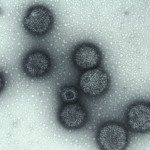Link to Pubmed [PMID] – 25043586
Virology 2014 Sep;464-465:26-32
Due to climate change and the propagation of competent arthropods worldwide, arboviruses have become pathogens of major medical importance. Early transmission to vertebrates is initiated by skin puncture and deposition of virus together with arthropod saliva in the epidermis and dermis. Saliva components have the capacity to modulate skin cell responses by enhancing and/or counteracting initial replication and establishment of systemic viral infection. Here, we review the nature of the cells targeted by arboviruses at the skin level and discuss the type of cellular responses elicited by these pathogens in light of the immunomodulatory properties of arthropod vector-derived salivary factors injected at the inoculation site. Understanding cutaneous arbovirus-host interactions may provide new clues for the design of future therapeutics.


